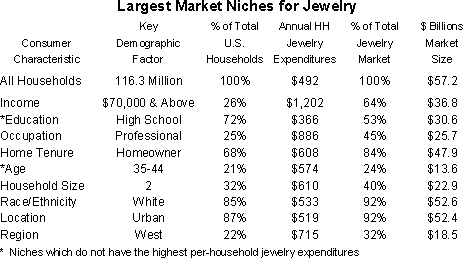IDEX Online Research: America’s Best Jewelry Market Niches
November 07, 06
Jewelry merchants need to identify market niches for advertising and marketing purposes. Aside from direct one-to-one marketing (direct mail, for example), it is difficult to identify and reach the “best” jewelry customer with mass media; the distinctions are too subtle and nuanced.
If jewelers can identify a large market niche which can be reached by one or more media – radio or television, for example – it is possible that they would be better off accepting a smaller average ticket (lower per-household jewelry expenditure), but generate greater aggregate revenues by reaching many more consumers. In addition, jewelers’ profits could be larger since lower-priced jewelry generally carries a higher gross margin.
Market Niches by Demographic Factors
Markets are segmented by the same demographic factors as individual consumers. That’s logical, since market segments are comprised of groups of individual consumers.
To arrive at the aggregate buying power or market potential of a market segment, we multiplied the average annual household jewelry expenditure by the total number of households in each demographic category. Thus, it is possible that a target market may have not have the highest average annual jewelry expenditure, but if the group is disproportionately large, the combination of the average annual expenditure multiplied by the total consumer units may yield a very large target market.
The table below summarizes the largest market niches for jewelry. For all demographic categories except education and age, the largest aggregate market is also the market with the highest per-household annual jewelry expenditures.
- In the case of age, the average annual household expenditure for 35-to-44 year olds, as shown on the table, is $574. This is the third largest per-household jewelry expenditure. Both 25-to-34 year olds and 55-to-64 year olds have larger per-household jewelry expenditures, but their total market niches – per-household spending multiplied by total number of households – are smaller in terms of total jewelry sales volume.
- Likewise, consumers with only a high school education spend a modest $366 per year on jewelry, well below both the national average of $492 per-household jewelry expenditure and far below the $818 per-household jewelry expenditure of college-educated consumers. But there are a disproportional number of households (72 percent of all American households) with only a high school education; thus, their total jewelry expenditures, as small as they are on a per-household basis, add up to a majority of the aggregate market (53 percent)
 Source: US Dept of Commerce |
This is a summary of the full article that appeared in the October 2006 issue of IDEX Magazine.